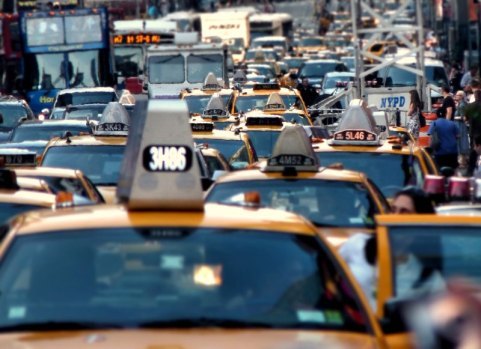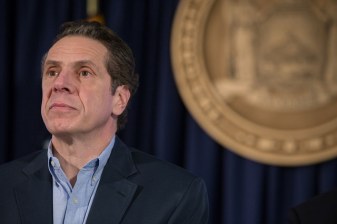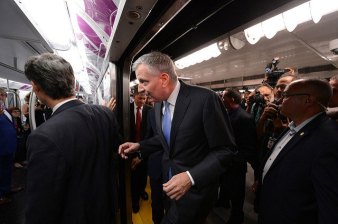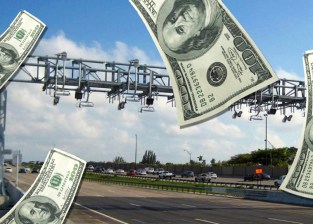KOMANOFF: With Cuomo Sidelined, the MTA Must Get Congestion Pricing Done
The operative words are 'simplify' and 'defer.'

Gov. Cuomo’s twisting fate could sideline the state’s executive branch for months. But Albany cannot afford to be distracted at best, dysfunctional at worst. One critical bit of business — congestion pricing — was already in limbo before the release on Tuesday of Attorney General Tish James’s bombshell report.
The city’s recovery can’t keep being held up by bureaucratic inaction. The Metropolitan Transportation Authority, which the 2019 congestion-pricing law anointed the “lead agency” to carry out the toll plan, needs to plunge full speed ahead.
There’s already been a four-month holdup since U.S. Transportation Secretary Pete Buttigieg told the MTA that a streamlined “environmental assessment” would satisfy federal review requirements — and that hold-up is largely a political contrivance. It’s true that lots of loose ends need to be tied up for congestion pricing to start, but delay is costly. By my reckoning, each day that cars and trucks freely drive in and out of Manhattan’s Central Business District costs New Yorkers nearly $10 million in time, health and sanity sacrificed to needless gridlock.

So it’s time for the MTA to fast-track congestion pricing’s nuts and bolts. Here’s how it can do it. The operative words are: “simplify” and “defer”:
- No new tolls on Holland and Lincoln tunnel users: The Port Authority has practiced a form of congestion pricing on its Hudson River tunnels by tolling them since their inception. The current tolls there, $13.75 peak and $11.75 off-peak (inbound only), are at least as high as what the MTA is likely to charge to cross 60th Street or use an East River bridge. There’s no need to add to them.
- Leave for-hire vehicles alone: Taxi, Uber and Lyft rides that touch the congestion zone, even just for a block, have been surcharged $2.50 or $2.75 since 2019. This one-size-fits-all approach is neither equitable nor efficient, and it should give way to per-minute charges. But that’s for later. For now, leave the surcharges in place and exempt for-hire vehicles from the congestion toll.
- No upstream toll credits: Pleas to exempt CBD-bound trips that have paid “upstream” tolls on the George Washington, Triboro or Henry Hudson Bridges make even less sense now, on account of their complexity. Let’s forget ’em.
- Pattern truck tolls on MTA’s bridges and tunnels: A single toll for trucks — a holdover from Mayor Bloomberg’s congestion-pricing attempt — is nonsensical. The MTA’s bridges and tunnels have tolled trucks based on the number of axles for decades. It should do likewise for congestion pricing.
- No new carve-outs: Residents inside the congestion zone, residents outside the toll boundary, and some representatives of uniformed city and state employees have demanded carve-outs from the congestion tolls. The enabling legislation wisely authorizes tax credits to low-income drivers who live south of 60th Street. End of discussion.
- Defer two-way tolling: Charging half the toll in each direction makes more sense, traffic-wise, than a one-way full toll. But the MTA should consider postponing two-way tolling until after the first 12 months, to streamline review and construction.
All of these policy levers are within the MTA’s purview.
2017 with @EliassonJonas talking about how popular Congestion Pricing was once it was implemented in Stockholm. https://t.co/adGhp3J5S4
— Streetfilms (Now 1,100+ films!) (@Streetfilms) August 3, 2021
These and any other steps that could simplify the toll engineering and penetrate the MTA’s bureaucratic smokescreen should be considered seriously. Time is not on congestion pricing’s side, as NPR journalist Camila Domonoske explained a couple of years ago: “Before pricing kicks in, people don’t really expect it to work.” It’s only once the tolls begin do people see that “it does work [and] experience the benefits firsthand.”
And the longer congestion pricing is stalled, the more half-baked schemes (like this and this) emerge to confuse the issue and rally objectors.
Leaving NYC’s congestion-pricing program to wander in what Stockholm’s congestion-pricing guru Jonas Eliason has called “the valley of political death” is a sure-fire way to let it die. New Yorkers deserve better.
Streetsblog contributor Charles Komanoff (@Komanoff) is an internationally recognized expert on congestion pricing and other mobility issues.


